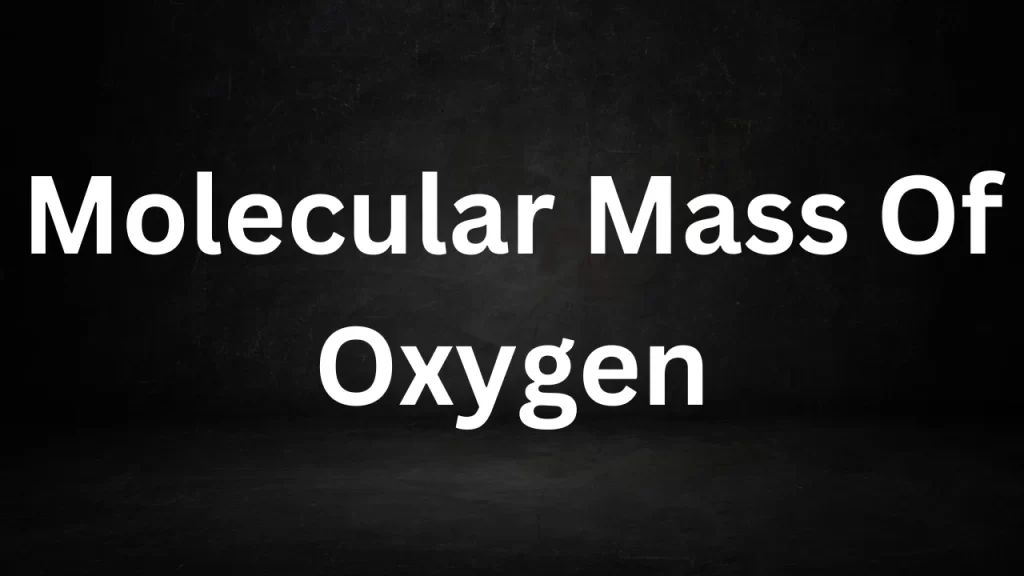Tag: Molecular Mass Of Oxygen
Molecular Mass Of Oxygen
Molecular Mass Of Oxygen: O2, often symbolized as O2, is the life-sustaining element that makes up a substantial portion of Earth’s atmosphere. Its importance in respiration, combustion, and various chemical processes is undeniable.
To fully grasp the significance of oxygen, it’s essential to understand its molecular mass, a fundamental property that reveals its weight and behavior in the natural world.

Molecular Mass Of Oxygen
Defining Molecular Mass
Molecular mass, also known as molecular weight or molar mass, is a measure of the total mass of a molecule. In the case of O2, this refers to the combined mass of the two O2 atoms that form a diatomic molecule. Molecular mass is typically expressed in atomic mass units (amu) or grams per mole (g/mol).
Calculating the Molecular Mass of Oxygen (O2)
To determine the molecular mass of O2, we must consider the atomic masses of the individual O2 atoms. The atomic mass of an element is defined relative to the mass of a carbon-12 atom, which is assigned a mass of exactly 12 atomic mass units (amu).
The atomic mass of O2 is approximately 15.9994 amu. Since O2 molecules consist of two O2 atoms, we can calculate the molecular mass of O2 as follows:
Molecular Mass of O2 = (Atomic Mass of O) * 2
Molecular Mass of O2 = (15.9994 amu) * 2
Molecular Mass of O2 ≈ 31.9988 amu
Hence, the molecular mass of O2 is approximately 31.9988 atomic mass units.
The Significance of Molecular Mass
Understanding the molecular mass of O2 is crucial in various scientific and practical applications:
1. Respiration:
- In the field of biology, the molecular mass of O2 is essential for calculating the amount of O2 consumed during respiration. This information is vital for understanding metabolic processes in organisms.
2. Stoichiometry:
- Chemists use molecular masses extensively in stoichiometry, where they calculate reactant and product masses in chemical reactions. This knowledge helps in determining reaction yields and balancing chemical equations.
3. Gas Laws:
- In the study of gases, such as in the ideal gas law, the molecular mass of O2 is a key parameter for predicting gas behavior under various conditions of temperature and pressure.
4. Environmental Science:
- Molecular mass plays a role in environmental studies, including air quality assessments. It helps in determining the composition of Earth’s atmosphere and monitoring changes due to pollution.
5. Industry and Technology:
- In industrial processes like combustion, the molecular mass of O2 is essential for optimizing fuel-air mixtures and ensuring efficient energy production.
Conclusion
The molecular mass of O2 is approximately 31.9988 atomic mass units, revealing its weight in chemical reactions, biological processes, and everyday applications.
This fundamental property allows scientists, engineers, and researchers to better understand and harness the power of O2, a vital element for life on Earth and an essential component in the world of chemistry and physics.
Read More
- Difference Between Light Microscope And Electron Microscope
- Molar Mass Of Aluminium
- Molecular Mass Of Glucose
- Latent Heat Of Water
- Difference Between Work And Power
Frequently Asked Question (FAQs) Molecular Mass Of Oxygen
1. What is the molecular mass of oxygen (O2)?
The molecular mass of oxygen (O2) is approximately 31.9988 atomic mass units (amu).
2. How is the molecular mass of oxygen calculated?
The molecular mass of oxygen (O2) is calculated by adding together the atomic masses of its constituent O2 atoms. Since O2 atoms have an atomic mass of approximately 15.9994 amu, the molecular mass of O2 is 2 times this value (2 * 15.9994 amu).
3. Why is knowing the molecular mass of oxygen important?
Understanding the molecular mass of O2 is essential in various scientific and practical applications. It is used in biology to calculate O2 consumption during respiration, in chemistry for stoichiometry and reaction balancing, and in environmental science for air quality assessments, among other uses.
4. Is the molecular mass of oxygen the same as its molar mass?
Yes, the molecular mass of O2is often referred to as its molar mass. Both terms refer to the mass of one mole of O2 molecules (O2), expressed in grams per mole (g/mol) or atomic mass units (amu).
5. How does the molecular mass of oxygen impact chemical reactions involving oxygen?
The molecular mass of O2 is crucial in chemical reactions where O2 is a reactant or product. It helps determine reactant and product masses, stoichiometry, and reaction yields.